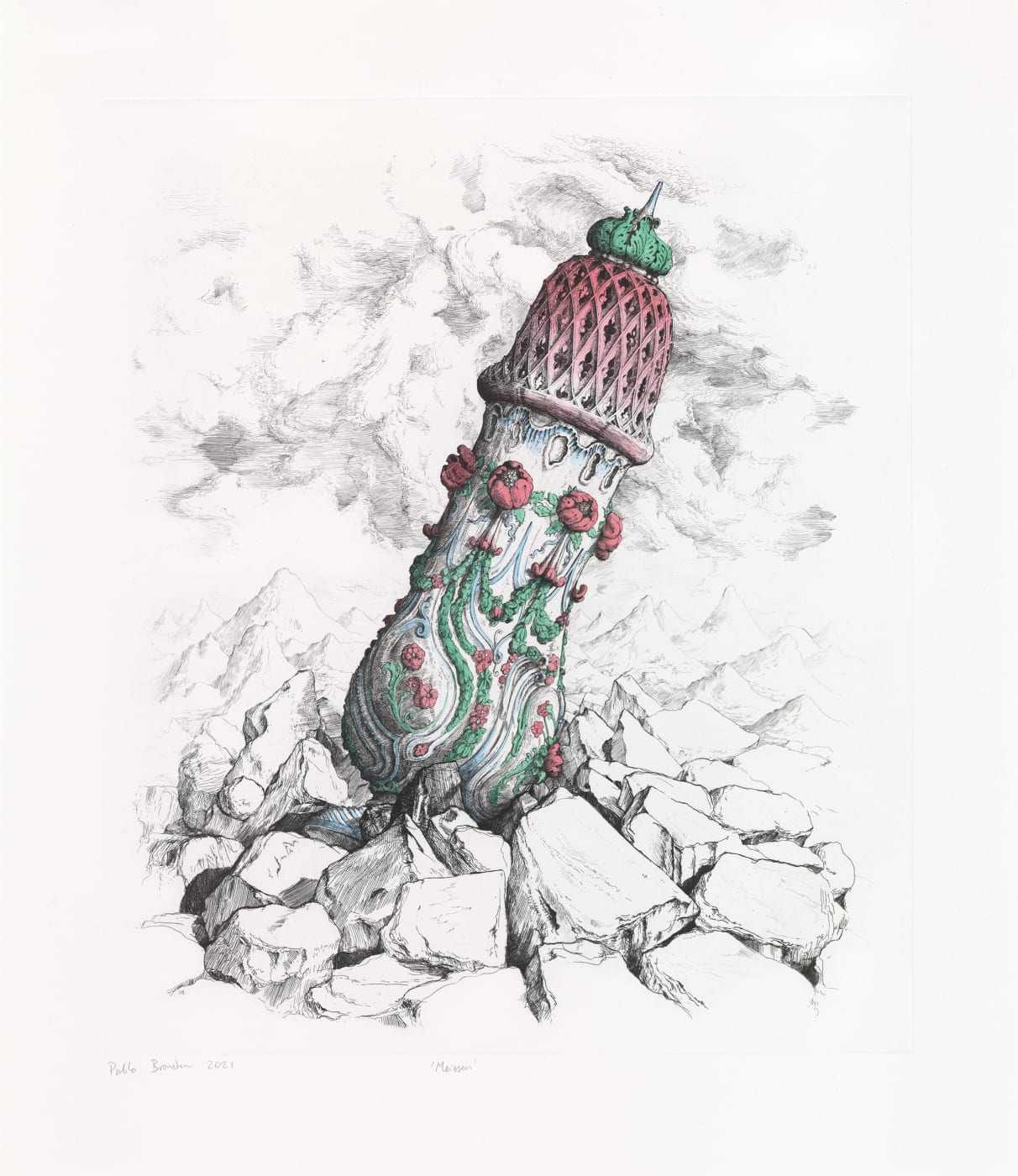Pablo Bronstein: Sugar Caster
Sugar Caster and Sugar Caster ‘Meissen’, 2021 are the latest pair of editions published with Pablo Bronstein. Both are hard-ground etchings with the latter also hand-coloured in homage to eighteenth century German porcelain makers.
Sugar Casters, now largely absent from contemporary dining tables, are items of great personal significance to Bronstein and he has a large personal collection of these beautifully crafted but now almost obsolete objects. Used exclusively by the wealthy between the seventeenth and nineteenth century, as only they could afford the small sugar granules which could be cast (caster sugar), and often made in silver or porcelain, they became signifiers of status, consumerism, trade and refined taste.
Bronstein’s rendering of such baroque phallic ornamentation, dramatically increased in scale to the proportions of architecture and placed on a mountain top, hilariously highlights both the form of these objects as well as the social aspirations they represent.
Bronstein’s body of work, which is often humorous, includes drawings, prints, choreography and performance, all of which have architecture at their heart. His intricate studies of pseudo historical European design constitute critiques of human folly and pretention. The act of hand-colouring is a further reference to Bronstein’s interest in pre-modern art history, and to the historical tradition of printmaking. Prior to the nineteenth century, the application of colour on prints was almost always done by hand.
Please view the works below and contact sales@cristearoberts.com if you require any further information or would like to book an appointment to view the prints at the gallery.
Top image: Joshua Monaghan
Dressing table, Lisbon earthquake, 2019
Dressing table, Lisbon earthquake, 2019, a hand-coloured etching, is an ironic, imaginary view of the aftereffects of the 1755 Lisbon earthquake in the form of a shattered domestic dressing table at the moment of impact.
The earthquake was one of the deadliest natural disasters of the eighteenth-century, destroying an entire city instantly. An entire civilization collapsed under its own weight and a whole way of life came to an abrupt end. The devastation led to a total reconsideration of science, philosophy and theology. The implications of the disaster were discussed widely by philosophers such as Voltaire and Kant and eventually culminated in the birth of The Age of Reason in Europe.
Elements of the composition, including the dressing table, are Baroque in style. Bronstein's depictions of eighteenth-century silverware are often also inspired by his own personal collection. The act of hand-colouring itself is also a reference to an historical tradition: prior to the nineteenth century, the application of colour on prints was almost always done by hand.
Pablo Bronstein on Roman artist Piranesi
The prints by Bronstein, pictured below, feature in a major group exhibition, For the Love of Master, 25 artists fascinated by Piranesi, which celebrates the legacy of the Italian architect, antiquarian, etcher, designer and writer, Piranesi.
"The design for a cake basket relates most immediately to Piranesi’s Roman city views, which I have made reference to by sitting the basket between large Roman palazzi to the left and right, on top of a plausible rather than implausible (as is the case with his prison scenes) bridge and embankment. I also used his trick of overscaling objects in order to add drama to an otherwise unremarkable object – such as we see with his pulleys or hooks, which take on colossal stature.
My cake basket is inflated to architectural proportions. My hypothetical design is also related to Piranesi’s hypothetical designs for decorative objects – clocks, silver etc. – which are similarly encrusted accumulations of decorations. From this point, my design moves closer to the Rococo designs of the French goldsmith Meissonier, who is more fluid and less Neoclassical. And finally, my print relates to Piranesi’s historicizing and spurious archaeology. Piranesi was known to have faked antiques and then drawn them as if recording and validating a genuine (and highly elaborate) Roman artefact. I have always found that engaged mockery or recreation of the past deeply fascinating." Pablo Bronstein
For the Love of Master, 25 artists fascinated by Piranesi, at The Coach House Gallery, Dublin Castle and the Casino at Marino, Dublin, Ireland
Open until 18 September 2022




